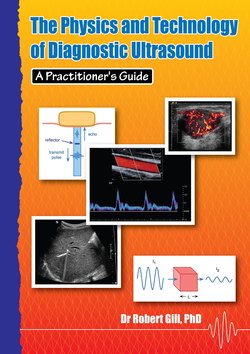Читать книгу The Physics and Technology of Diagnostic Ultrasound: A Practitioner's Guide - Robert Gill - Страница 34
На сайте Литреса книга снята с продажи.
Principles of image formation
ОглавлениеThe previous sections have described the basis of ultrasound imaging:
The machine's probe transmits a short pulse of ultrasound into the patient's body.
This pulse travels along a defined pathway referred to as the ultrasound "beam".
Structures within the beam cause some of the transmitted energy to be reflected and scattered.
Some of the reflected and scattered energy travels back along the beam to the probe, where it is detected and converted into an electrical signal.
The signal due to an individual structure is referred to as an "echo". As we have seen, by measuring the exact arrival time of an echo the machine can calculate the distance from the probe to the structure that caused it. The machine also knows the position of the beam relative to the probe, and so it is able to define relatively accurately where the structure is within the ultrasound image. This allows it to place a point in the image to represent the structure, as shown in Figure 3.9.
Figure 3.9 (Left) Reflected ultrasound returning to the probe will give rise to an echo signal. (Right) On the machine's display the echo will be displayed as a dot. Note that it is placed in the image (the black rectangle) at the correct depth and on a "line of sight" that corresponds to the centre-line of the beam.
The brightness of the dot is determined by the intensity of the echo. A weak echo will be shown as a dark grey, a moderate intensity echo as a mid-grey and a strong echo as white. Black is shown when no echoes are detected.
Three standard types of probe are used with ultrasound machines (see Figure 3.10):
linear arrays;
curved arrays (sometimes called "curvilinear" or "convex" arrays);
phased arrays.
Figure 3.10 (left to right) Typical linear, curved and phased array probes.
As we will see shortly, the word "array" refers to the fact that the transducer (the active element in the probe) is sliced into a large number of identical transducer "elements" to facilitate electronic focussing and scanning of the ultrasound beam.
Figures 3.11, 3.12 and 3.13 illustrate the scan patterns and image shape for these three probe types. Why are different types of probe used in different clinical applications? The answer lies in their relative strengths and limitations. These relate to considerations such as the physical size of the probe (often called its "footprint"), the available "acoustic window" into the patient (i.e. the area in the superficial tissues through which ultrasound can travel) and the shape and elasticity of the skin where the probe is to be placed.
In some areas (e.g. transthoracic echocardiography, where the ultrasound must travel between ribs and must avoid the lungs) the acoustic window is extremely limited. In other areas (e.g. late pregnancy scans) the acoustic window is large and therefore not such a concern.
Figure 3.11 (a) In a linear array the beam is stepped from left to right for successive transmit pulses (only the first three beam positions are shown).
Figure 3.11 (b) As the beam moves from one end of the probe to the other it sweeps out a rectangular field of view and so the image (black) is rectangular.
Figure 3.12 A curved array is similar to a linear array. However, due to the curvature of the probe the lines of sight are not parallel but instead sweep out a radial path. This type of probe therefore provides a significantly wider field of view than the linear array.
Figure 3.13 Phased array. The point of origin of the beam remains fixed. It is scanned by steering it in a series of different directions. The resulting image provides a good field of view at depth, but virtually no information about superficial tissues.
In summary:
Linear array: ideal for relatively flat surfaces such as the neck and limbs; however, the field of view is limited by the probe dimensions.
Curved array: widely useful, probably the standard probe in most clinical areas; the field of view diverges with depth, so it is not so limited by probe size or the acoustic window; the degree of divergence depends on the degree of curvature of the probe and so it can be tailored to suit a given clinical application.
Phased array: the dominant probe type in echocardiography; compact, easily manipulated and able to make use of a very small acoustic window; major limitation is the lack of detail close to the probe.
Two other types of probe are available for use in specific situations, namely invasive and 3D probes.
Invasive probes include transvaginal (see Figure 3.14), transrectal and transoesophageal. As with standard probes they use array technology to focus and scan the beam.
Figure 3.14 Transvaginal probe.
An advantage often claimed for ultrasound is that it is non-invasive, so why are invasive probes used? There are two reasons. First, some areas are virtually impossible to reach with ultrasound from the skin surface because of intervening gas and bone. An invasive probe can get very close to the region of interest (ovaries, prostate, aortic outflow tract etc) and so avoid the problems relating to overlying tissues.
Secondly, the fact that the probe is close to the tissues of interest means that a higher frequency can be used and so the image resolution is improved over what could be achieved with standard (non-invasive) scanning.
As discussed in chapter 12, 3D imaging places an extra requirement on the probe. The scan plane must be swept through the patient's tissues in order to acquire echo information from a three dimensional volume. Historically this has been achieved by moving the transducer, either manually or mechanically. More recently, however, it has become possible to achieve the same thing electronically using "matrix" transducers, which will be discussed more fully in chapter 4.
